

This chapter introduces existential verbs and shows how they are frequently used to express the existence of things and people or their locations. It also introduces a lot of words for animals, plants, and home-related terms such as rooms in a house and household items. You’ll also learn how to give directions, how to express human relationships, and how to talk about events and incidents using existential verbs.
 aru,
aru,  iru, and
iru, and  irassharu
irassharuThe existential verbs  aru,
aru,  iru, and
iru, and  irassharu are used to express the existence of something or someone as well as where he/she/it is. The person or thing that exists is the subject noun, and it is marked by the particle
irassharu are used to express the existence of something or someone as well as where he/she/it is. The person or thing that exists is the subject noun, and it is marked by the particle  ga unless it functions as a topic at the same time. On the other hand, the location where something or someone exists is marked by the particle
ga unless it functions as a topic at the same time. On the other hand, the location where something or someone exists is marked by the particle  ni.
ni.  aru (to exist) is used for inanimate items.
aru (to exist) is used for inanimate items.  aru is a slightly irregular u verb: its nai form is
aru is a slightly irregular u verb: its nai form is  nai.
nai.  iru (to exist) is used for animate items such as people and animals. It is a ru verb.
iru (to exist) is used for animate items such as people and animals. It is a ru verb.  irassharu (to exist) is the polite version of
irassharu (to exist) is the polite version of  iru and is used for people to whom the speaker wants to show respect, such as his teacher and boss.
iru and is used for people to whom the speaker wants to show respect, such as his teacher and boss.  irassharu is also a slightly irregular u verb: its stem form is
irassharu is also a slightly irregular u verb: its stem form is  irasshari as you would correctly predict, but its masu-form is
irasshari as you would correctly predict, but its masu-form is  irasshaimasu. The major forms of these three existential verbs are summarized in the following table. The symbol * marks the slightly irregular forms.
irasshaimasu. The major forms of these three existential verbs are summarized in the following table. The symbol * marks the slightly irregular forms.
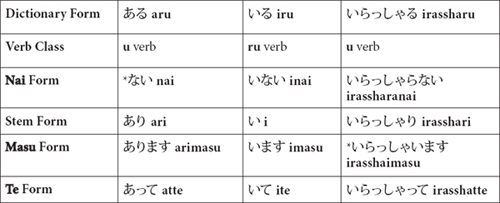
The following demonstrative pronouns for locations are parallel to demonstrative pronouns for things discussed in Chapter 2:

 d
d butsu means animal. The following are words for some animals you may see in your neighborhood or at a zoo:
butsu means animal. The following are words for some animals you may see in your neighborhood or at a zoo:
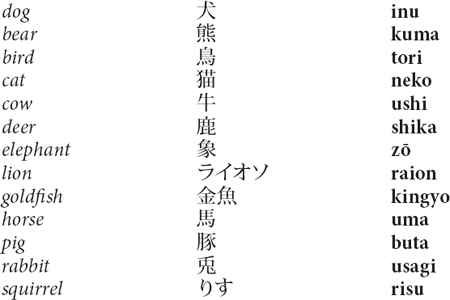
 shokubutsu means plant. The following are words for some plants you may see in your backyard or at a park:
shokubutsu means plant. The following are words for some plants you may see in your backyard or at a park:

 …
…  … ni (wa) … ga arimasu/imasu
… ni (wa) … ga arimasu/imasuIf you want to express the existence of something, such as say with surprise, “Look! There is a cherry tree over there!” or simply telling what is in some place, as in “There is a cherry tree in my yard,” use an existential verb and mark the item with the subject particle  ga. For example:
ga. For example:
Asoko ni sakura no ki ga arimasu.
There is a cherry tree over there.
Uchi no uraniwa ni wa sakura no ki ga arimasu.
There is a cherry tree in my backyard.
The same applies to the verbs  iru and
iru and  irassharu. For example:
irassharu. For example:

A! Asoko ni usagi ga imasu yo.
Oh! There is a rabbit over there!

Asoko ni Tanaka sensei ga irasshaimasu ne.
Professor Tanaka is over there, isn’t she?
 …
…  … wa … ni arimasu/imasu
… wa … ni arimasu/imasuIf you want to express the location of something, use an existential verb and mark the item with the topic particle  wa. For example:
wa. For example:
Yamada-san no mise wa Sakura-d
ri ni arimasu.
Ms. Yamada’s store is located on Sakura Street.
The same applies to  iru and
iru and  irassharu. For example:
irassharu. For example:
Yamada-san wa asoko ni imasu.
Ms. Yamada is over there.
Yamada-sensei wa asako ni irasshaimasu.
Professor Yamada is over there.
So, if you want to ask the location of someone or something, say it and add  wa, and then say
wa, and then say  doko ni and one of the existential verbs. For example:
doko ni and one of the existential verbs. For example:

Tanaka-san wa doko ni imasu ka.
Where is Mr. Tanaka?

Mach the items in the two columns.

Mach the items in the two columns.

For each of the following, choose the appropriate answer from the items in the parentheses.
1. 
Asoko ni resutoran ga (arimasu, imasu, irasshaimasu).
2. 
Asoko ni usagi ba (arimasu, imasu, irasshaimasu).
3. 
Asoko ni onna no ko ga (arimasu, imasu, irasshaimasu).
4. 
Asoko ni sensei ga (arimasu, imasu, irasshaimasu).
5. 
Asoko ni sakura no ki ga (arimasu, imasu, irasshaimasu).

What would you say in Japanese in the following situations?
1. You want to find out where Mt. Fuji is located.
2. You want to say that there are dogs in Ms. Yamada’s house.
3. You want to know where Mr. Tanaka is.
4. Someone is wondering where Mr. Tanaka is, and you want to say that he is at the library.
5. You’ve just noticed Mary in the distance, and you want to tell your friend who is sitting next to you about it.
To express what you have or what you don’t have in your house, start with  uchi ni wa and then the noun marked with the subject particle
uchi ni wa and then the noun marked with the subject particle  ga, and end your sentence with an existential verb. You can also include a number phrase, as discussed in Chapter 3. For example:
ga, and end your sentence with an existential verb. You can also include a number phrase, as discussed in Chapter 3. For example:

Uchi ni wa shinshitsu ga mittsu arimasu.
Our house has three bedrooms.

Uchi ni wa shako ga arimasen.
We don’t have a garage in our house.

Uchi ni wa reiz ko ga ni-dai arimasu.
ko ga ni-dai arimasu.
We have two refrigerators in our house.
In almost all Japanese houses, people take off their shoes at the entryway. They might have Japanese-style rooms and/or Western-style rooms. The Japanese style is to have the toilet in a separate room from the bathing room. The following terms are used for rooms and areas in a house:
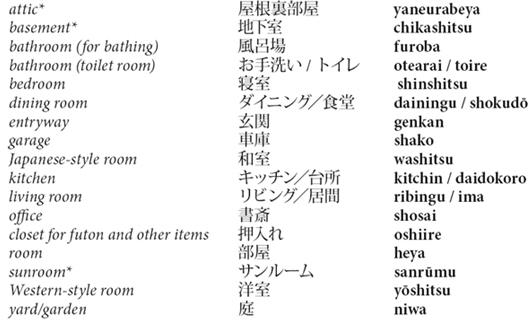
_____________
*Japanese houses rarely have a basement, an attic, or a sunroom.
Do you have the following items in your home or apartment?
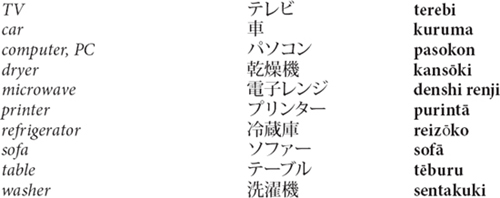
The following terms are used for things in a bedroom:


Write the following words in Japanese.
1. TV________________________
2. refrigerator________________________
3. bed________________________
4. chair________________________
5. desk________________________

Answer the following questions for your own situation.
1. 
(Anata no) uchi ni wa terebi ga nan-dai arimasu ka.
2. 
Reiz ko wa nan-dai arimasu ka.
ko wa nan-dai arimasu ka.
3. 
Pasokon wa nan-dai arimasu ka.

Translate the following sentences into Japanese.
1. There are three TVs at Mike’s house.
2. There is no yard in Ms. Mori’s house.
3. There is a basement room in Mary’s house.
4. There is no washer and dryer in George’s apartment.

Read the following passage and answer the questions that follow.

Watashi no heya ni wa tsukue ga hito-tsu to beddo ga hito-tsu to isu ga mit-tsu arimasu. Sorekara honbako ga hito-tsu to t buru ga hito-tsu arimasu. Zasshi ga go-satsu? arimasu. Sorekara manga to g
buru ga hito-tsu arimasu. Zasshi ga go-satsu? arimasu. Sorekara manga to g musofuto ga takusan arimasu.
musofuto ga takusan arimasu.
1. How many chairs are there?
2. How many tables are there?
3. How many magazines are there?

Describe what you have in your room.
You can describe where things are relative to other things by using relative location words or compass directions.
To describe the location of things and buildings, use relative location words, such as  ue (top/upper area) or
ue (top/upper area) or  chikaku (nearby area), along with the reference item. For example:
chikaku (nearby area), along with the reference item. For example:
Zasshi wa t
buru no ue ni arimasu.
The magazines are on the table.
Gink
wa eki no chikaku ni arimasu.
The bank is near the train station.
The following table lists a number of relative location words and provides examples of their use:
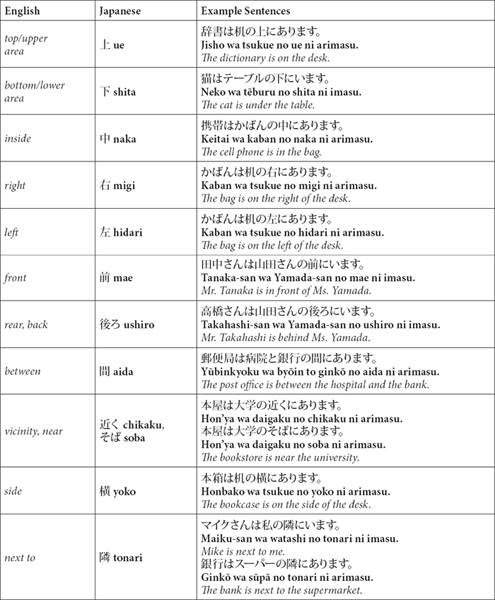
The following terms are used for compass directions:


Translate the following sentences about someone’s room into Japanese.
1. The bookcase is on the side of the desk.
2. The desk is in front of the window.
( mado means window)
mado means window)
3. The dictionary is in the drawer of the desk.
4. The sofa is between the desk and the bed.

Translate the following sentences about a town into Japanese.
1. The post office is on the south of the university.
2. The restaurant is between the hospital and the bookstore.
3. The bank is next to the city hall.
4. My apartment is near the elementary school.

Read the following passage written by Keiko and answer the questions that follow.

Eki wa machi no ch shin ni arimasu. Y
shin ni arimasu. Y binkyoku wa sh
binkyoku wa sh gakk
gakk no kita ni arimasu. Sh
no kita ni arimasu. Sh b
b sho wa sh
sho wa sh gakk
gakk no mae ni arimasu. By
no mae ni arimasu. By in wa sanban-d
in wa sanban-d ri ni arimasu. Toshokan mo sanban-d
ri ni arimasu. Toshokan mo sanban-d ri ni arimasu. Gink
ri ni arimasu. Gink wa Sakura-d
wa Sakura-d ri ni arimasu. S
ri ni arimasu. S p
p wa by
wa by in no tonari ni arimasu. Watashi no uchi kara s
in no tonari ni arimasu. Watashi no uchi kara s p
p made jitensha de go-fun desu.
made jitensha de go-fun desu.
( eki means train station;
eki means train station;  machi means town;
machi means town;  ch
ch shin means center; …
shin means center; …  d
d ri means … Street)
ri means … Street)
1. Where is the train station?
2. Where is the bank located?
3. How long does it take to go from Keiko’s house to the supermarket?
To give directions in Japanese, you must know some words for landmarks such as  k
k saten (intersection) and
saten (intersection) and  hashi (bridge) along with the ordinal counter creater …
hashi (bridge) along with the ordinal counter creater … me (…th). You must also know some verbs of movement such as
me (…th). You must also know some verbs of movement such as  magaru (to make a turn) and
magaru (to make a turn) and  wataru (to cross). It is helpful to connect sentences in your directions with conjunctions such as
wataru (to cross). It is helpful to connect sentences in your directions with conjunctions such as  sorekara and
sorekara and  s
s suruto; both of them mean then with different usage.
suruto; both of them mean then with different usage.
The following are some words for landmarks you may need in giving directions:

The following are some verbs for movement you may need in giving directions:

 o
oThe particle  o can be used with a verb that expresses movement such as going, crossing, turning, or passing. For example:
o can be used with a verb that expresses movement such as going, crossing, turning, or passing. For example:

Kono michi o massugu itte kudasai.
Please go straight on this street.
 ni
niThe particle  ni can mark the direction for movement, such as to the right, to the left, to the north, and to the south. For example:
ni can mark the direction for movement, such as to the right, to the left, to the north, and to the south. For example:

Migi ni magatte kudasai.
Please make a right turn.
 sōsuruto (then)
sōsuruto (then) s
s suruto can show “automatic results,” or something that always happens when used in the non-past tense. For example:
suruto can show “automatic results,” or something that always happens when used in the non-past tense. For example:

Kono michi o massugu itte kudasai. S suruto, migi ni gink
suruto, migi ni gink ga arimasu.
ga arimasu.
Please go straight on this road. Then you’ll see a bank on your right.
 me
meTo say first, second, third, etc., you can add  me to any numeral-counter combination. For example:
me to any numeral-counter combination. For example:

san-satsu-me no hon
the third book

futa-tsu-me no k saten
saten
the second intersection

Translate the following sentences into Japanese.
1. Please go straight on this street.
2. Please make a left turn at that intersection.
3. Please pass the bus stop.
4. Please cross that bridge.
5. Please make a right turn at the third corner.

Following are directions to Michiko’s house. Complete them with the correct particles. Note that the demonstrative adjective  sono can be used for things that the people conversing cannot see but that the speaker knows about and mentions in the discourse.
sono can be used for things that the people conversing cannot see but that the speaker knows about and mentions in the discourse.
Kono michi o massugu itte kudasai. Sorekara mit-tsu me ____ k saten o migi ____ magatte kudasai. S
saten o migi ____ magatte kudasai. S suruto fumikiri ga arimasu. Sono fumikiri ____ watatte kudasai. Sorekara go-fun gurai aruite kudasai. S
suruto fumikiri ga arimasu. Sono fumikiri ____ watatte kudasai. Sorekara go-fun gurai aruite kudasai. S suruto migi ni pan’ya ____ arimasu. Watashi no ap
suruto migi ni pan’ya ____ arimasu. Watashi no ap to wa sono pan’ya no tonari ni arimasu.
to wa sono pan’ya no tonari ni arimasu.
You can use  iru to express what human relationships you have. For example:
iru to express what human relationships you have. For example:
Watashi wa Nihon-jin no tomodachi ga san-nin imasu.
I have three Japanese friends.
The following words describe human relationships:


Translate the following sentences into English.
1. 
Watashi wa im to ga futari imasu.
to ga futari imasu.
2. 
Watashi wa im to ga futari to ot
to ga futari to ot to ga hitori imasu.
to ga hitori imasu.
3. 
Yamada-san wa ky dai ga imasu ka.
dai ga imasu ka.
4. 
Watashi wa ky dai ga imasen.
dai ga imasen.
5. 
Ani wa kon’yakusha ga imasu.
6. 
Chen-san wa itoko ga san-j -nin imasu.
-nin imasu.

Read the following dialog between Keiko and Mary and answer the questions that follow.
1. How many siblings does Mary have?
2. What do you think the underlined part of the dialog means?
3. How many cousins does Mary have?
4. How many siblings does Keiko have?
By using the verb  aru, you can express events and incidents. Note that the locations of events and incidents are marked by
aru, you can express events and incidents. Note that the locations of events and incidents are marked by  de rather than by
de rather than by  ni even though an existential verb is used. For example:
ni even though an existential verb is used. For example:
Ky
wa
saka de mensetsu ga arimasu in.
I have an interview today in Osaka.
Kesa Sendai de jishin ga arimashita.
There was an earthquake in Sendai this morning.
Some natural disasters are expressed using verbs such as  kuru (come),
kuru (come),  naru (become),
naru (become),  okiru (occur/take place), and
okiru (occur/take place), and  hassei suru (occur/take place).
hassei suru (occur/take place).
The following terms are used to describe commonly occurring events:
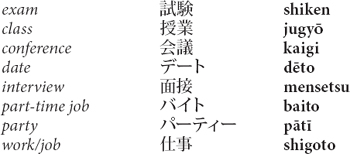
The following terms are used to describe unscheduled events, such as accidents, incidents, and disasters:

 sorede (as a result)
sorede (as a result) sorede shows an expected result or resulting decision. Do not use it to express commands, requests, suggestions, invitations, conjectures, or the speaker’s volition.
sorede shows an expected result or resulting decision. Do not use it to express commands, requests, suggestions, invitations, conjectures, or the speaker’s volition.

 saka de kaigi ga arimashita. Sorede
saka de kaigi ga arimashita. Sorede  saka ni is-sh
saka ni is-sh kan imashita.
kan imashita.
There was a conference in Osaka. So I was in Osaka for one week.

Sendai de  kii jishin ga arimashita. Sorede tsunami ga kimashita.
kii jishin ga arimashita. Sorede tsunami ga kimashita.
There was a big earthquake in Sendai. As a result, a tsunami hit there.

Translate the following sentences into English.
1. 
Ky wa jugy
wa jugy ga mittsu arimasu. Desukara shigoto ni wa ikimasen.
ga mittsu arimasu. Desukara shigoto ni wa ikimasen.
2. 
Ky wa shigoto ga arimasen. Desukara isshoni kaimono ni ikimasen ka.
wa shigoto ga arimasen. Desukara isshoni kaimono ni ikimasen ka.
3. 
Ashita wa mensetsu to shiken ga arimasu. Sorede ky wa doko ni mo ikemasen.
wa doko ni mo ikemasen.

Read the following paragraph written by Seiji and answer the questions that follow.

Getsuy bi to Suiy
bi to Suiy bi to Kiny
bi to Kiny bi wa Nihon-go no kurasu ga arimasu. Ku-ji kara j
bi wa Nihon-go no kurasu ga arimasu. Ku-ji kara j -ji made desu. Kiny
-ji made desu. Kiny bi no ban wa Nihon no resutoran de baito ga airmasu. Go-ji kara j
bi no ban wa Nihon no resutoran de baito ga airmasu. Go-ji kara j -ji made desu.
-ji made desu.
(…  kara …
kara …  made means from … to …)
made means from … to …)
1. Which days does Seiji have classes?
2. Which days does he have to work?
3. From what time to what time does he have to work?

List your weekly schedule in Japanese.

Read the following passage and answer the questions that follow.

Ni-sen-j -ichi-nen san-gatsu j
-ichi-nen san-gatsu j -ichi-nichi ni Nihon no T
-ichi-nichi ni Nihon no T hoku Chih
hoku Chih no chikaku no Taiheiy
no chikaku no Taiheiy oki de magunich
oki de magunich do ky
do ky no jishin ga okimashita. Sorede T
no jishin ga okimashita. Sorede T hoku Chih
hoku Chih ni
ni  kii tsunami ga kimashita. Kasai mo genshiryoku hatsudensho no jiko mo okimashita.
kii tsunami ga kimashita. Kasai mo genshiryoku hatsudensho no jiko mo okimashita.
( T
T hoku Chih
hoku Chih means Tohoku Region, the northeastern portion of Honshu in Japan;
means Tohoku Region, the northeastern portion of Honshu in Japan;  Taiheiy
Taiheiy means Pacific Ocean;
means Pacific Ocean;  oki means open sea;
oki means open sea;  genshiryoku hatsudensho means nuclear power plant)
genshiryoku hatsudensho means nuclear power plant)
1. When did the earthquake occur?
2. Where did it occur?
3. What was the result?